 |
 |
 |
| |
Up to Half in Older DC Cohort Not Treated for Metabolic Comorbidities - High Burden of Comorbidities in Inner City Washington DC
|
| |
| |
7th International Workshop on HIV and Aging, September 26-27, 2016, Washington, DC
"These findings have important implications for the evolving health care needs of people aging with HIV in real-world clinical settings....Very high burden of certain comorbidities among older patients
..... In an aging citywide contemporary cohort of largely non-Hispanic black HIV outpatients, we found a high prevalence of metabolic comorbidities despite access to health care and the availability of newer ARV regimens with improved metabolic side effect profiles
......Among patients aged ≥70, 78% had ≥2 metabolic comorbidities, including 44% with exactly two comorbidities, 27% with exactly 3 comorbidities, and 7% with all four comorbidities....Each metabolic outcome was independently associated with either depression or anxiety/stress disorder....Having a nadir CD4 count <200 (vs. >500) was associated with greater odds of hypertension....There was evidence of hypertension, dyslipidemia, and multimorbidity among more than half of those aged 50-59 and a large majority of those aged 60+, and there was evidence for type 2 diabetes in approximately one-quarter of those aged 60+."

Mark Mascolini
In a cohort of 7000 HIV-positive adults in Washington, DC, more than one third with hypertension or diabetes had no record of therapy for those conditions, and more than half with dyslipidemia apparently went untreated [1]. Three quarters of participants 70 years old or older had two or more of the four metabolic comorbidities assessed-hypertension, type 2 diabetes, dyslipidemia, and obesity.
Researchers from George Washington University and collaborating centers noted that estimating prevalence of metabolic conditions that predispose to cardiovascular disease can help characterize the epidemiology of this important HIV comorbidity and contribute to promoting lifestyle and pharmacologic interventions. To that end, the researchers estimated citywide prevalence of the four noted conditions in HIV outpatients and explored differences by age, sex, and race/ethnicity.
The analysis involved all adults with HIV in the DC Cohort, a prospective observational study of outpatients at 13 centers across the city. The researchers identified metabolic comorbidities by reviewing electronic medical records for ICD-9 codes and other factors that contribute to hypertension, diabetes, dyslipidemia, and obesity. They assessed prevalence cross-sectionally over the period 2011-2015 by age and demographic subgroup.
Among 7018 cohort participants, 73% were men and 77% non-Hispanic black. Median age stood at 50 years (interquartile range [IQR] 39 to 57), and 18% of participants were 60 or older. Median time since HIV diagnosis measured 12.3 years (IQR 6.7 to 19.5).
Overall 2011-2015 prevalence of hypertension was 50% (95% confidence interval [CI] 49 to 51), dyslipidemia 48% (95% CI 47 to 49), obesity 35% (95% CI 34 to 36), and type 2 diabetes 13% (95% CI 12 to 14). The conditions proved highly prevalent in people 60 and older: hypertension prevalence was 74% in the 60-to-69 group and 86% in the 70-and-older group; diabetes prevalence was 24% in the 60-to-69 group and 29% in the 70-and-older group; and dyslipidemia prevalence was 68% in the 60-to-69 group and 74% in the 70-and-older group.
Among people 70 years old or older, 78% (95% CI 72 to 83) had at least two metabolic conditions, including 44% with exactly two conditions, 27% with three, and 7% with all four. Men proved more likely than women to have abnormal lipids (51% versus 41%, P < 0.001), whereas women were more likely to have diabetes (16% versus 12%, P < 0.001) and obesity (53% versus 29%, P < 0.001).
Among people who met diagnostic criteria for dyslipidemia, 56% lacked evidence of treatment, as did 40% with diabetes and 38% with hypertension.
Multivariable analysis determined that longer time since HIV diagnosis raised chances of diabetes and dyslipidemia; longer time taking a protease inhibitor raised chances of dyslipidemia; longer time on a nonnucleoside raised chances of hypertension and dyslipidemia; and longer time on any regimen raised chances of hypertension and dyslipidemia. Longer time on a nonnucleoside and longer time on any regimen each lowered chances of obesity about 5% per year.
The researchers proposed that "models of HIV care that more centrally incorporate primary and secondary prevention of metabolic disease may be warranted to effectively monitor and treat metabolic risk factors and prevent subsequent adverse cardiovascular outcomes among aging HIV-infected patients."
Reference
1. Levy ME, Greenberg AE, Hart R, Powers Happ L, Hadigan C, Castel A. High burden of metabolic co-morbidities in a citywide cohort of HIV outpatients: evolving health care needs of people aging with HIV in Washington, DC. 7th International Workshop on HIV and Aging, September 26-27, 2016, Washington, DC. Abstract 6.

Metabolic comorbidities have been examined in other HIV cohorts in the United States and internationally. However, robust population-level prevalence estimates based on recent data are largely unavailable: data collection for studies has mostly occurred prior to 2010, metabolic variables were often reported as baseline covariates in longitudinal analyses or in smaller sub-studies focused on other health outcomes, and restrictive analytic inclusion/exclusion criteria have sometimes resulted in study samples that were not representative of the larger population of HIV patients.
In the setting of HIV infection, cardiovascular disease remains associated with traditional risk factors such as aging, smoking, and genetic predisposition, but is also attributed to changes induced by HIV and its treatment, including chronic inflammation, immune activation, and immune deficiency, and the effects of specific antiretroviral drugs on plasma lipids, insulin resistance, inflammation, and immune function.
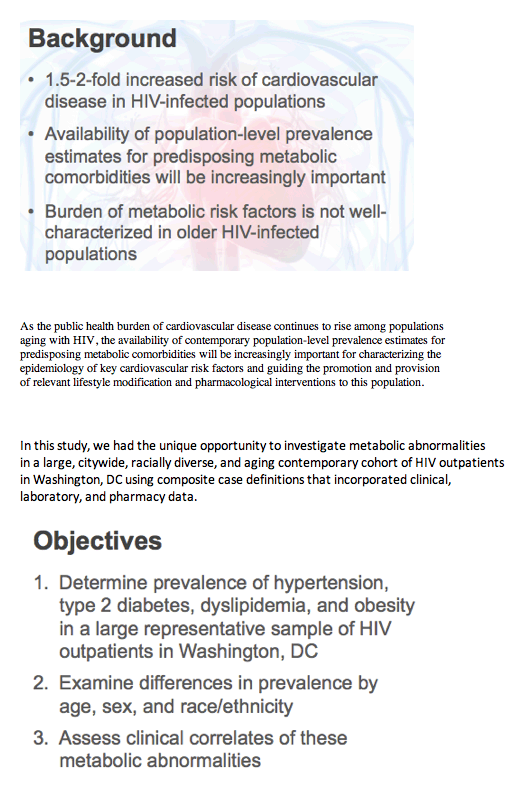
As the public health burden of cardiovascular disease continues to rise among populations aging with HIV, the availability of contemporary population-level prevalence estimates for predisposing metabolic comorbidities will be increasingly important for characterizing the epidemiology of key cardiovascular risk factors and guiding the promotion and provision of relevant lifestyle modification and pharmacological interventions to this population.
In this study, we had the unique opportunity to investigate metabolic abnormalities in a large, citywide, racially diverse, and aging contemporary cohort of HIV outpatients in Washington, DC using composite case definitions that incorporated clinical, laboratory, and pharmacy data.
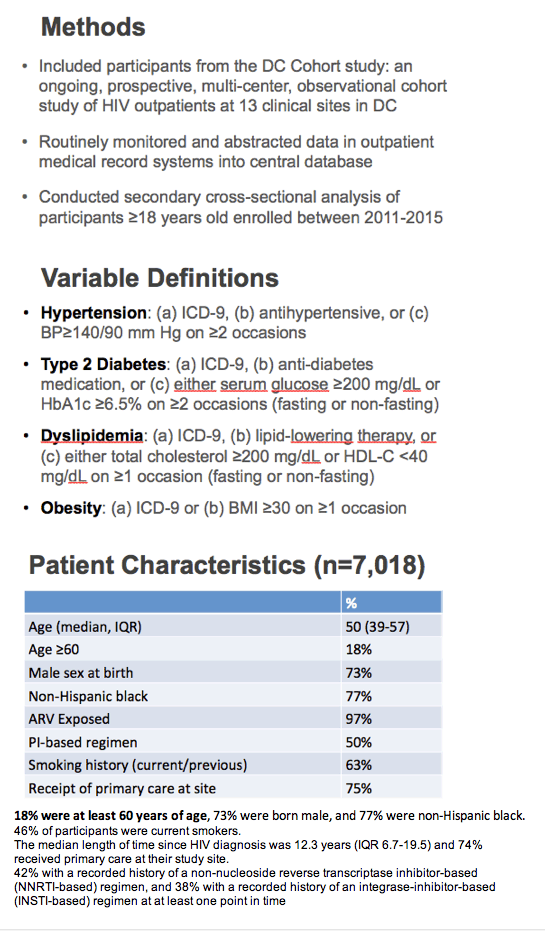
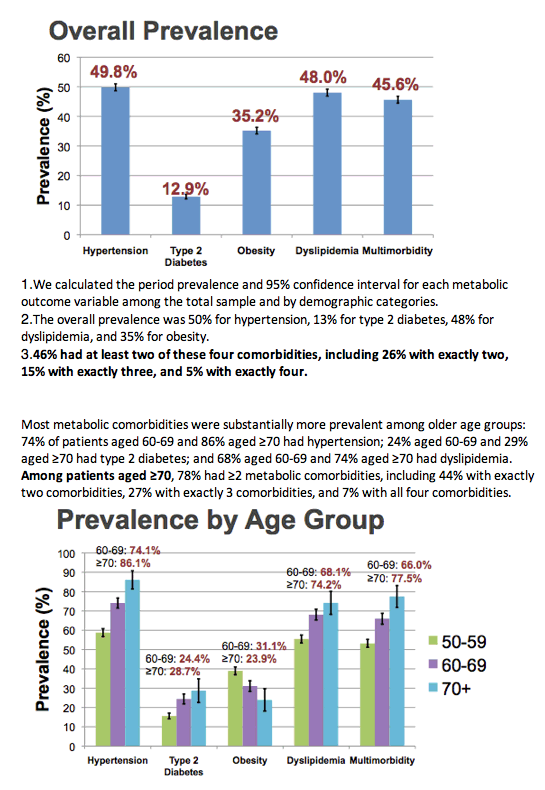
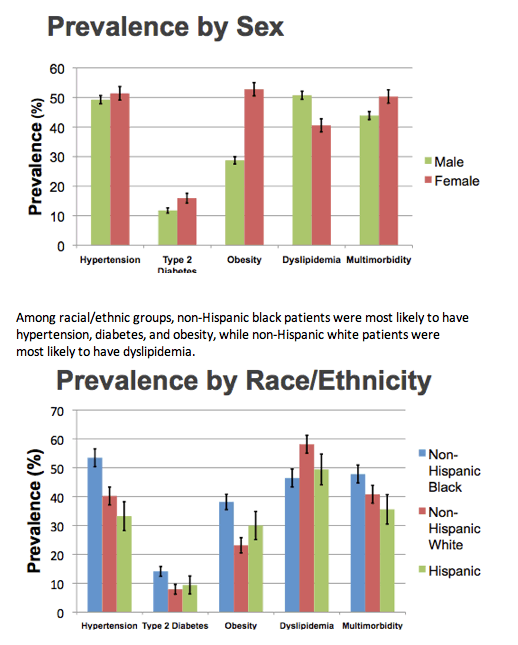
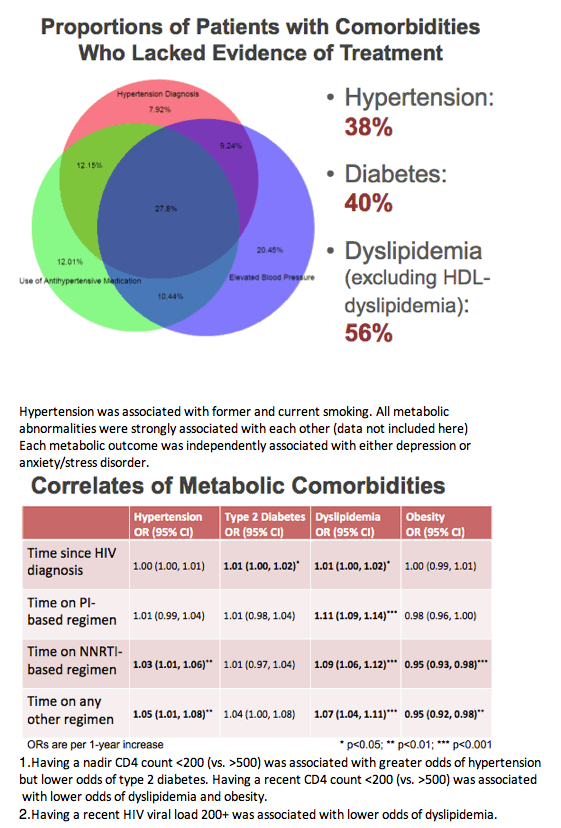
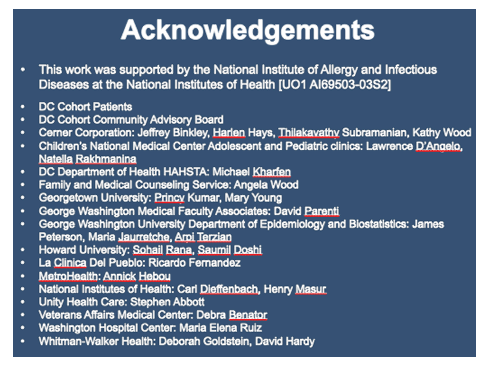
|
| |
|
 |
 |
|
|